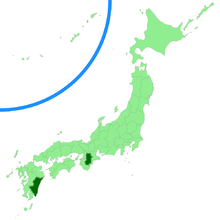| Chorioactis | |
|---|---|

| |
| Chorioactis geaster | |
| Scientific classification | |
| Domain: | Eukaryota |
| Kingdom: | Fungi |
| Division: | Ascomycota |
| Class: | Pezizomycetes |
| Order: | Pezizales |
| Family: | Chorioactidaceae |
| Genus: | Chorioactis Kupfer ex Eckblad (1968)[1] |
| Species: | C. geaster
|
| Binomial name | |
| Chorioactis geaster | |

| |
| Distribution in Texas (above), and Japan (below) shown in red and dark green, respectively. | |

| |
| Synonyms | |
|
Urnula geaster Peck (1893)[2] | |
Chorioactis is a genus of fungi that contains the single species Chorioactis geaster.[4] The mushroom is commonly known as the devil's cigar or the Texas star in the United States, while in Japan it is called kirinomitake (キリノミタケ). This extremely rare mushroom is notable for its unusual appearance and disjunct distribution; it is found only in select locales in Texas and Japan. The fruit body, which grows on the stumps or dead roots of cedar elms (in Texas) or dead oaks (in Japan), somewhat resembles a dark brown or black cigar before it splits open radially into a starlike arrangement of four to seven leathery rays. The interior surface of the fruit body bears the spore-bearing tissue known as the hymenium, and is colored white to brown, depending on its age. The fruit body opening can be accompanied by a distinct hissing sound and the release of a smoky cloud of spores.
Fruit bodies were first collected in Austin, Texas, and the species was named Urnula geaster in 1893; later it was found in Kyushu in 1937, but the mushroom was not reported again in Japan until 1973. Although the new genus Chorioactis was proposed to accommodate the unique species a few years after its original discovery, it was not accepted as a valid genus until 1968. Its classification has also been a source of confusion. Historically, Chorioactis was placed in the fungus family Sarcosomataceae, despite inconsistencies in the microscopic structure of the ascus, the saclike structure in which spores are formed. Phylogenetic analyses of the past decade have clarified the fungus's classification: Chorioactis, along with three other genera, make up the family Chorioactidaceae, a grouping of related fungi formally acknowledged in 2008. In 2009, Japanese researchers reported discovering a form of the fungus missing the sexual stage of its lifecycle; this asexual state was named Kumanasamuha geaster.
- ^ a b Cite error: The named reference
Eckblad1968was invoked but never defined (see the help page). - ^ Cite error: The named reference
Peck1893was invoked but never defined (see the help page). - ^ Cite error: The named reference
Kupfer1902was invoked but never defined (see the help page). - ^ Although geaster means "earth star", this fungus is not related to the species Geaster or any of the Geastraceae.